

3PK 4PK 5PK 6PK 7PK 8PK 10PK 12PK Automobile Fan Drive Timing Transmission Belt Rubber V Pk Belt Pulley














Rubber pulley belts are integral to the efficient operation of various machinery, playing a pivotal role in the power transmission sector. These belts, typically made from robust rubber materials, are designed to facilitate the transfer of power between shafts in an array of industrial applications. This introduction delves into the various aspects of rubber pulley belts, from their types and applications to the materials used in their construction.
The versatility of rubber pulley belts is evident in their wide range of types, each suited to specific applications. Small rubber pulley belts are commonly used in lightweight machinery, whereas heavy-duty pulley belts cater to more demanding power transmission needs. The conveyor pulley lagging type is essential in material handling industries, enhancing the grip between the belt and pulley. In the realm of automotive transmissions, these belts are indispensable for their role in altering gear ratios and ensuring smooth vehicle operation.
The construction of a rubber pulley belt is a testament to engineering precision, with materials selected for their durability and performance. The rubber lagging for conveyor pulley is a prime example, designed to resist wear and tear in harsh conditions. The pulley lagging rubber not only prolongs the belt's lifespan but also minimizes maintenance needs. Materials typically include synthetic rubber variants, known for their strength and elasticity, ensuring the belts can withstand the rigors of continuous use.
The advantages of employing rubber pulley belts in machinery are manifold. These belts offer excellent tensile strength and are less prone to slippage, ensuring consistent power transmission. The rubber drive pulley system is particularly beneficial in applications requiring precise speed control. Furthermore, the rubber belt for pulley systems is designed for noise reduction, contributing to a quieter operational environment.
Different pulley lagging types cater to varied operational demands. The selection of the appropriate lagging, such as conveyor roller lagging or conveyor pulley lagging types, is crucial for optimal performance. These variations are engineered to improve belt tracking and extend the belt's service life by protecting it against environmental factors and operational stresses.
In conclusion, rubber pulley belts are a cornerstone in the domain of mechanical power transmission. Their design and material composition make them suitable for a broad spectrum of industrial applications. By understanding the different types and features of these belts, businesses can ensure they select the right component for their machinery, leading to enhanced efficiency and longevity of their equipment.